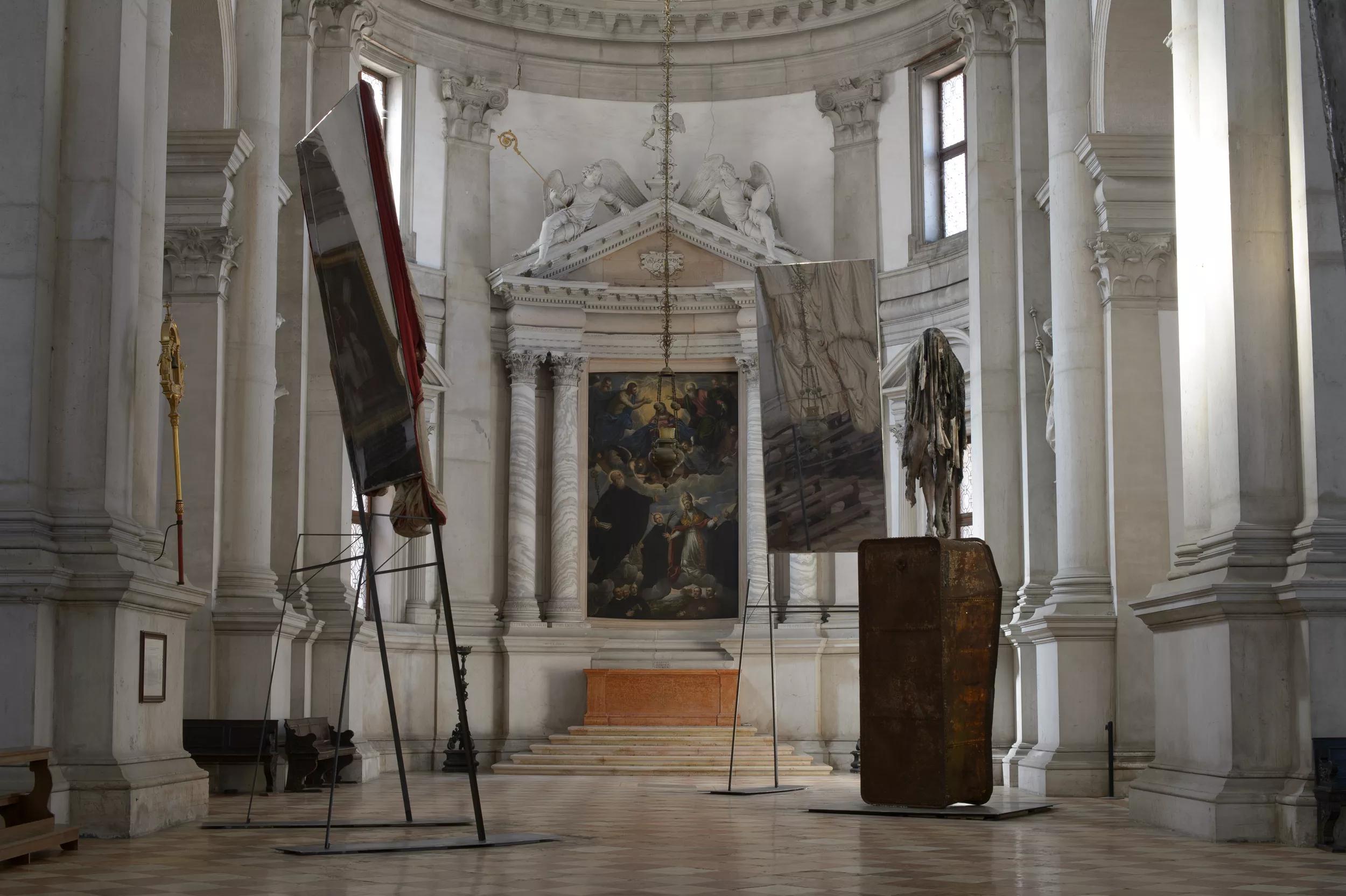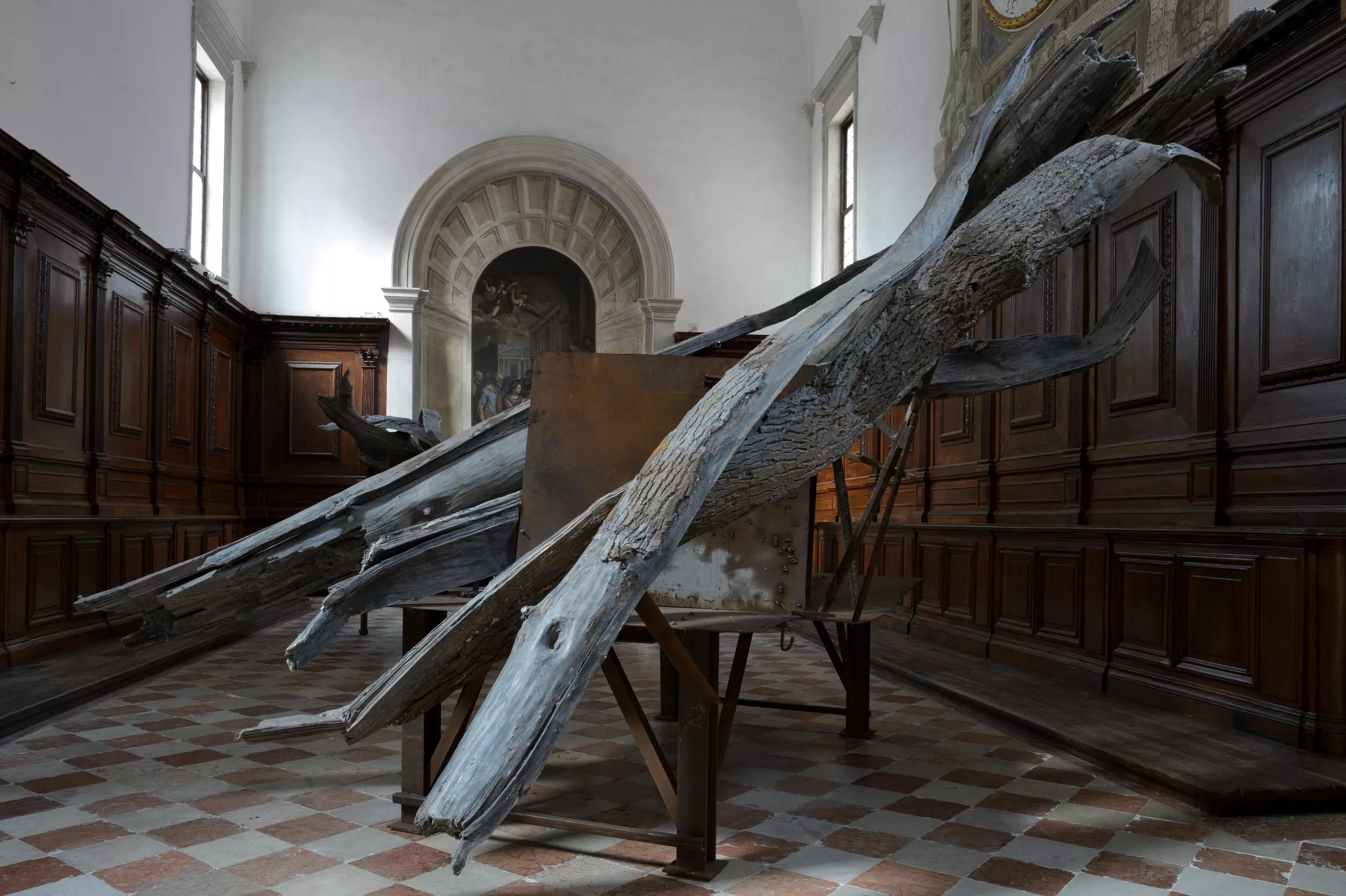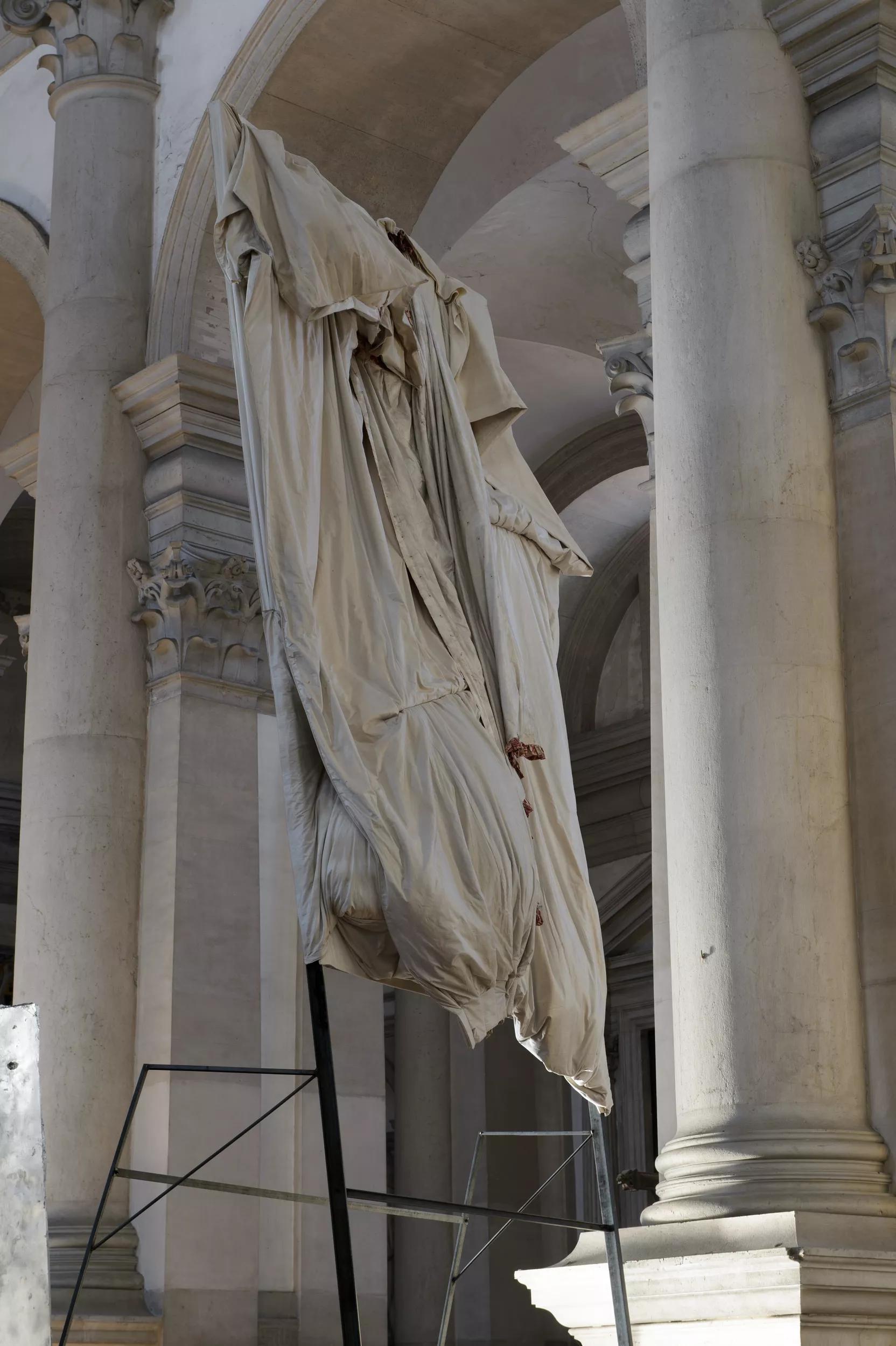Conversations
Expressions of the Soul
On Berlinde De Bruyckere’s new work and secular art in sacred spaces

Berlinde De Bruyckere, “City of Refuge III,” Abbazia di San Giorgio Maggiore, Venice/IT, April 20 – November 24, 2024. Photo: Mirjam Devriendt
- 17 May 2024
- Issue 10
- Artwork © Berlinde De Bruckyere
- Related Artist
- Berlinde De Bruyckere
In 2012, the Benedicti Claustra Onlus was founded as a non-profit branch of the Abbey of San Giorgio Maggiore in Venice. Established with the aim of renewing the church’s dialogue with living artists, the project has also served to increase public awareness of the artistic vocation of the church’s monastic community. Working alongside director and institutional curator Carmelo A. Grasso, San Giorgio Maggiore’s Benedictine monks help select and oversee site-specific installations for the basilica of the landmarked 16th-century church. Benedicti Claustra Onlus’s next presentation will be Berlinde De Bruyckere’s “City of Refuge III,” opening on April 20.
In preparation for the exhibition, De Bruyckere met with Grasso and Abbot Stefano Visintin at San Giorgio Maggiore Abbey on January 10 to talk about the ideas behind her new work and the merits and challenges of staging contemporary art in a religious space. These are edited portions of their conversation.

View from the bell tower of the Abbey of San Giorgio Maggiore. Photo: Lorenzo Palmieri
Carmelo A. Grasso: It’s so nice to be with you, Berlinde. I’ve known your work for twelve years, possibly more, and I immediately fell in love with it. I said to myself, “One day in the abbey, we must do an exhibition with Berlinde.” When I received the proposal for your exhibition, I informed the monks, and we were immediately sure that we must do it.
Berlinde De Bruyckere: Thank you. San Giorgio Maggiore is a place I hold dear, and I believe the time is right for this project. For some time now, I have been working on a series of exhibitions titled “City of Refuge,” focusing on the idea of art as a sanctuary in places that have a history in this regard. For me, it is important to connect the idea of a city of refuge with the church, a place in which people historically found shelter.
Abbot Stefano Visintin: It’s a fitting title. Venice has been called a city of refuge. It can be, for people who not only need help or are sick but also people searching for meaning in life. This is part of why we are involved in this dialogue with contemporary art.
CG: It is also a refuge of the soul.
SV: Obviously we have now arrived at a point where religion and contemporary art are not exactly going in the same direction. This used to be the case, but it has weakened over the past few centuries.
BDB: Thinking about the proposals that I did for the church, Carmelo, I understand why you mentioned that you had followed my work already. There is a spiritual aspect to it.
CG: There is, although we are not necessarily looking for religious subjects. Let me say, there also is something more . . . perhaps through the element of skin, which I find to be an important part of your work. The skin is something that is so close with us.
BDB: Something we can touch. The tactile aspect is essential to my work.
CG: Yes. When I stand in front of your artwork, the receptors of my skin start to feel emotion. Sometimes it is negative, sometimes positive, but what is important is that I start to empathize with you, with your process, with your art. It can feel transcendental—something that touches us directly as human beings.
BDB: The skin is something that is so personal, so recognizable.
CG: I immediately recognize it in your wax sculpture. It is the surface that is especially emotional for me. The wax also feels like something that connects to the Italian monasteries’ ancient traditions of candle-making and the ceremony of using candles during mass.
“My Arcangelo is not the angel of the annunciation. I think he’s much more human.”—Berlinde De Bruyckere

Berlinde De Bruyckere, City of Refuge I, 2023-2024, 2024. Wax, iron, epoxy. Photo: Mirjam Devriendt
SV: Also, I think that in our current culture it is important to think about the body, seeing how we are always on the internet and so much of our life is virtual. There is the danger in thinking of yourself as only a pure spirit, when the reality is we are not. We are embodied—we have to pass through the body for everything, in relation to others. Having only virtual friends would be a loss of humanity. In the end, what’s the difference between us and artificial intelligence? One thing is sure: artificial intelligence can never feel.
BDB: It does not have emotion.
SV: Exactly—it doesn’t touch or see things. It can only calculate. It does not know the sensations we have.
BDB: It is through the body that we can feel and that we can express ourselves. I often say the body is the container of the soul. Confronting the viewer with a physical experience is what my work is all about.
SV: Yes, though I would say that the body is not only the container of the soul—the body is the expression of the soul. It is the sign, the symbol of the soul. You cannot separate the two.
BDB: For me, having the human figure in my work is very important because that is what we know the best. In this same vein, I use trees, horses, deer—there is no hierarchy between them. I appropriate them all in the same manner, as icons. They are equally familiar elements we relate to as human beings, among which we live.
CG: Although at the same time, it’s possible for this recognition to feel confusing. The figures or trees in your work can be very strange. They can look like something that is destroyed in some way or transformed into something else.
BDB: Always.
CG: Sometimes it’s better to become confused, because when you lose your reason, you find emotion that allows you to empathize with the artist or with the artwork. This is a point in your work and also your process.
BDB: I completely agree. My use of religious themes is rooted in my boarding school days. My first encounter with the image was through paintings and sculptures of religious topics. They started my imagination. I was trying to understand them while listening to stories from the Bible. This was the very start of my creative process. Meanwhile, so many other images have entered my world. I’ve traveled to so many places, so many different continents with other religions or with no religion.

Installation view, "Berlinde De Bruyckere. City of Refuge III," Abbazia di San Giorgio Maggiore, Venice, Italy, 2024. Collateral Event of the 60th International Art Exhibition—La Biennale di Venezia © Berlinde De Bruyckere. Photo: Mirjam Devriendt

Installation view, Abbazia di San Giorgio Maggiore, "Berlinde De Bruyckere. City of Refuge III," Venice, Italy, April 20 - November 24, 2024. Photo: Mirjam Devriendt
SV: Our selection of art and artists has always been about transcendental research, the need to interact with art and to find a place within the basilica—as Tintoretto, Ricci, Carpaccio and many others did in the past—as well as to think about the needs of the artists to get closer to the divine dimension and translate it or at least try to present it to the public.
BDB: I feel that as human beings, we are always striving for something of a higher order.
SV: This is something connected with human desire, to find something that gives you a sense of life.
BDB: I think human beings are looking for rituals, not just in a religious sense, but in a more general cultural way. Even in everyday life, we find rituals that ground us and grant us structure, define the rhythm of our day.
SV: For me, life in a Benedictine monastery is regulated by a rhythm of prayer, work and reading. The Benedictine community is the oldest order in Venice, and from the start we have always been involved in cultural activities. Part of the challenge in the present day is that people are accustomed to the traditional visual language of the church, but they may not necessarily understand or connect with it anymore.
BDB: This is something I noticed when I visited and sat on a bench and observed for a period of time. Some people enter the church and go around in five minutes and then they go right back out.
SV: This can happen especially if it is something people are used to. It no longer has an impact. At this point, some people have lost the understanding of the specific symbols or iconography. They register only as familiar and expected things. They don’t raise any questions for a visitor. They might feel as unnoticeable as the sun rising or the sun going down.
“Venice has been called a city of refuge. It can be, for people who not only need help or are sick but also people searching for meaning in life. This is part of why we are involved in this dialogue with contemporary art.”—Abbot Stefano Visintin

Carmelo A. Grasso, Berlinde De Bruyckere and Abbot Stefano Vistinin in front of Giuseppe Porta (also known as Salviati)’s Presentation of Jesus in the Temple, 1575–91/96 approx., Abbey of San Giorgio Maggiore. Photo: Lorenzo Palmieri
CG: Especially because people think that when you are working in a preserved church, the iconography is fundamental.
SV: With our art installations, visitors can have something else that can force them to think more about what they see.
CG: Exactly. If you put new artwork into a church, it can become even more powerful than presenting it in a museum or gallery, because it raises the question of why it’s there.
BDB: It’s important for me to think about bringing the subject of the angel back into the church. When you look at the sculptures without knowing that they are arcangelos, nobody would see them as angels. But once you know that the title of the work is Arcangelo, it transforms what you see and what you feel.
SV: Also in this case, the name “arcangelo” can give a direction to people. It can raise questions and lead to thinking, “Why is the arcangelo this way?”
CG: Berlinde, your Arcangelo has come to say something, though we don’t necessarily understand what it is that he wants to say to us. He’s not a cute blond angel, which is what we traditionally know from culture. You can be afraid about this kind of arcangelo, and there is a power in this. It’s more real.
BDB: My Arcangelo is not the angel of the annunciation. I think he’s much more human.
CG: He is a message himself. What you observed about people visiting the church and leaving quickly can be true. However, since the time that we started to show site-specific artwork in the church, we also see surprise from visitors. When people come inside, they normally expect to see classical paintings, the altar masterpiece and traditional objects. When they see site-specific contemporary artwork, this can be challenging to process. Sometimes the reaction of surprise is positive, but many times it can be negative. In the beginning, it was a little difficult. Sometimes it can still feel that way, because we have to overcome prejudices people may have about contemporary art inside a church. And for us, we must remember that the basilica is a consecrated space. Monks do services regularly, and it functions as a normal community church, with occasional weddings and other ceremonies. It’s not a museum, which is very important to remember.
“People ask me how it’s possible to bring contemporary art inside the church. And I always answer, ‘Why not?’ Art started in the church, in a religious space, which was the original place to bring art into people’s lives. Museums and galleries would come only later.”—Carmelo A. Grasso
Berlinde de Bruyckere and Abbot Emeritus Norberto Villa OSB inside the Belgian artist’s exhibition
BDB: For me, the big question was how to react to and respond to what is already there in the church. I think about the painting of Jesus and the temple in the sacristy. For me, this is a very powerful painting that encompasses everything from life until death, with all the questions in between. It is the reason I wanted to bring a huge installation into this particular area of the church. You really feel yourself being very small when you are in this space.
CG: This is also felt through the works presented in the sacristy, which are massive pieces of iron.
BDB: Right. The rusty iron tables are very heavy and imposing, but they also have branches made out of wax, which are fragile and break easily. For some of the branches, I use flesh-toned colors so they become more like bodies than trees. I want to give a sense of how nature works. Sometimes nature is fantastic in how it creates so much beauty and life, yet at the same time, look at all the catastrophes in the world. Nature can destroy a whole village in half an hour. I want the duality of the kindness and brutality of nature to be felt in this installation.
CG: It gives an extraordinary feeling of being in a forest that is more or less destroyed. We see the process of death and also what comes next—the virgulto, the new branch, a message of life.
SV: Berlinde, returning to the arcangelos, the way you position mirrors around them produces different sensations for me. First, in the mirror, you have a reflection of the basilica. It gives a symmetry that feels Palladian. And the angels are reflected as well, so we see more of them.
BDB: It was important to me to reflect on and connect to the architecture of the basilica. Apart from enhancing the presence of the angels, the mirrors also add an element of being in between states, in between the material and the transcendental.
CG: We don’t really host painting or traditional sculpture. We present installations that people go around. Sometimes people even move through the artwork. This allows them to become a part of it. And in thinking about why an artist brought this work into the church, people can also start to reflect on the religious masterpieces around them.
SV: It allows for a deeper reflection and contemplation.
BDB: In another place, this installation would not be the same.
CG: In the past, artists without the church could not express their art in certain ways, and the church without artists could not explain the depth and mystery of faith. The inclusion of contemporary artworks within a sacred space may seem like an original and almost provocative concept, but it makes sense. People ask me how it’s possible to bring contemporary art inside the church. And I always answer, “Why not?” Art started in the church, in a religious space, which was the original place to bring art into people’s lives. Museums and galleries would come only later.
SV: We feel it’s extremely important to recover this partnership and collaborate again. I think people also come to Venice because the city is a piece of art in itself. Continuing to offer art in a city of art feels like a natural avenue for us.
CG: The first responsibility of the community is to choose what to bring to the public. It’s always a dialogue between our organization and artists, and also the government. There is the Soprintendenza, the office that authorizes our projects. It’s a very nice process. Venice is a city where art happens naturally, through the Biennale especially. It is an extraordinary and spiritual place. It’s suspended in the water—and for that and other reasons, it’s of course very fragile. We don’t know what the future will be for Venice. But we are here now, presenting art in San Giorgio Maggiore Abbey.
SV: It is an opportunity.
CG: A great opportunity.
BDB: For me, too.
–
“City of Refuge III,” curated by Carmelo A. Grasso, Ory Dessau and Peter Buggenhout, opened as a collateral event of the 60th International Art Exhibition — La Biennale di Venezia on April 20, and will remain on view through November 24.
–
Belgian artist Berlinde De Bruyckere is recognized for her haunting distortions of organic forms, centered on motifs of vulnerability, fragility, the suffering of man and the overwhelming power of nature. She has had numerous institutional solo shows. In 2013, she represented Belgium in the 55th La Biennale di Venezia with her monumental installation Kreupelhout – Cripplewood (2013).
Carmelo A. Grasso is director and institutional curator of the Benedicti Claustra Onlus, the non-profit branch of the Abbey of San Giorgio Maggiore in Venice. Together with the Benedictine community, he selects all exhibitions for the abbey and oversees their presentation.
Stefano Visintin OSBA, OSB, who holds a bachelor’s degree in physics and a Ph.D. in theology, is abbot of the Monasteries of Praglia in Teolo, Padua and San Giorgio Maggiore, Venice. Abbot Visintin is also a professor of theology at the Pontifical Athenaeum of St. Anselmo in Rome, where he was previously Rector Magnificus.
